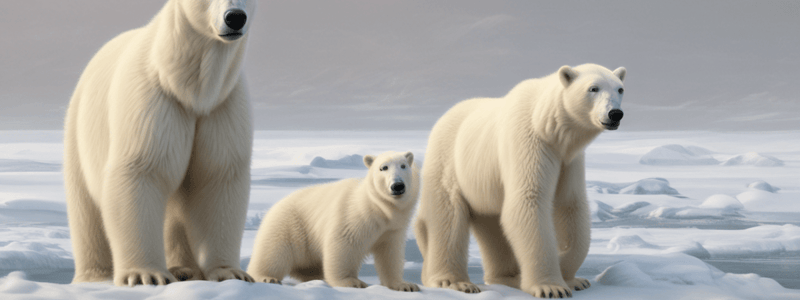Podcast
Questions and Answers
What is the average weight of a male polar bear?
What is the average weight of a male polar bear?
- 1000-1200 kg
- 300-800 kg (correct)
- 800-1000 kg
- 200-300 kg
What is a unique feature of the skull of a polar bear compared to a brown bear?
What is a unique feature of the skull of a polar bear compared to a brown bear?
- It has a narrower, flatter and smaller skull (correct)
- It has larger canines
- It has a longer snout
- It has a larger skull
What is the purpose of the hair on a polar bear's feet?
What is the purpose of the hair on a polar bear's feet?
- To increase grip on ice
- To decrease grip on ice
- To reduce friction on ice
- To provide warmth and friction on snow and sea ice (correct)
How much can a polar bear's weight fluctuate during the year?
How much can a polar bear's weight fluctuate during the year?
What is the average length of a male polar bear?
What is the average length of a male polar bear?
What is the purpose of a polar bear's claws?
What is the purpose of a polar bear's claws?
What is unique about the teeth of a polar bear?
What is unique about the teeth of a polar bear?
What is the purpose of the long hairs on the forelegs of male polar bears?
What is the purpose of the long hairs on the forelegs of male polar bears?
What is the primary function of the transparent guard hairs of polar bears?
What is the primary function of the transparent guard hairs of polar bears?
What is the reason for the yellowish coloration of polar bears' fur after they are exposed to the sun?
What is the reason for the yellowish coloration of polar bears' fur after they are exposed to the sun?
What is the purpose of the black skin of polar bears, including their nose and lips?
What is the purpose of the black skin of polar bears, including their nose and lips?
How do polar bears regulate their body temperature to prevent overheating?
How do polar bears regulate their body temperature to prevent overheating?
What is unique about the eyes of polar bears?
What is unique about the eyes of polar bears?
What is the range of frequencies that polar bears can hear best?
What is the range of frequencies that polar bears can hear best?
What is the purpose of the reniculate kidneys of polar bears?
What is the purpose of the reniculate kidneys of polar bears?
Flashcards are hidden until you start studying
Study Notes
Physical Characteristics
- Polar bears are the largest living species of bear and land carnivore, with males typically measuring 200-250 cm (6.6-8.2 ft) in length and weighing 300-800 kg (660-1,760 lb).
- Females are smaller, measuring 180-200 cm (5.9-6.6 ft) in length and weighing 150-300 kg (330-660 lb).
- Males have proportionally larger heads than females.
- Adults can stand 130-160 cm (4.3-5.2 ft) tall at the shoulder.
- The tail is 76-126 mm (3.0-5.0 in) long.
Diet and Teeth
- Polar bears have a more carnivorous diet than brown bears, with longer, sharper, and more spaced-out canines.
- They have smaller, more pointed cheek teeth (premolars and molars) and a large space or diastema between the canines and cheek teeth.
- This adaptation allows them to better bite into prey.
Paws and Claws
- Polar bears have large paws, with the front paws being broader than the back.
- The feet are hairier than in other bear species, providing warmth and friction when stepping on snow and sea ice.
- The claws are small but sharp and hooked, used for snatching prey and climbing onto ice.
Coat and Insulation
- The coat consists of dense underfur around 5 cm (2.0 in) long and guard hairs around 15 cm (5.9 in) long.
- The outer surface of the hairs has a scaly appearance, and the guard hairs are hollow, trapping heat and allowing the animals to float in the water.
- The transparent guard hairs forward scatter ultraviolet light between the underfur and the skin, leading to a cycle of absorption and re-emission, keeping them warm.
- The fur appears white due to the backscatter of incident light and the absence of pigment.
Thermoregulation
- Polar bears have a 5-10 cm (2.0-3.9 in) thick layer of fat underneath the skin, providing both warmth and energy.
- They maintain their core body temperature at about 36.9 °C (98 °F).
- Overheating is countered by a layer of highly vascularized striated muscle tissue and finely controlled blood vessels.
Other Adaptations
- The eyes are close to the top of the head, allowing them to stay out of the water when swimming at the surface.
- They are relatively small, which may be an adaptation against blowing snow and snow blindness.
- Polar bears are dichromats, lacking the cone cells for seeing medium, mainly green, wavelengths.
- They have many rod cells, allowing them to see at night.
- The ears are small, allowing them to retain heat and not get frostbitten.
- They can hear best at frequencies of 11.2-22.5 kHz, a wider frequency range than expected.
- The nasal concha creates a large surface area, allowing more warm air to move through the nasal passages.
- The olfactory system is also large and adapted for smelling prey over vast distances.
Studying That Suits You
Use AI to generate personalized quizzes and flashcards to suit your learning preferences.




